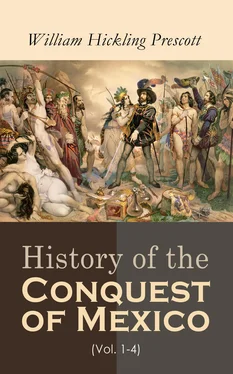There are, however, undoubted proofs of considerable age to be found there. Trees have shot up in the midst of the buildings, which measure, it is said, more than nine feet in diameter. [444]A still more striking fact is the accumulation of vegetable mould in one of the courts, to the depth of nine feet above the pavement. [445]This in our latitude would be decisive of a very great antiquity. But in the rich soil of Yucatan, and under the ardent sun of the tropics, vegetation bursts forth with irrepressible exuberance, and generations of plants succeed each other without intermission, leaving an accumulation of deposits that would have perished under a northern winter. Another evidence of their age is afforded by the circumstance that in one of the courts of Uxmal the granite pavement, [446]on which the figures of tortoises were raised in relief, is worn nearly smooth by the feet of the crowds who have passed over it; [447]a curious fact, suggesting inferences both in regard to the age and population of the place. Lastly, we have authority for carrying back the date of many of these ruins to a certain period, since they were found in a deserted, and probably dilapidated, state by the first Spaniards who entered the country. Their notices, indeed, are brief and casual, for the old Conquerors had little respect for works of art; [448]and it is fortunate for these structures that they had ceased to be the living temples of the gods, since no merit of architecture, probably, would have availed to save them from the general doom of the monuments of Mexico.
If we find it so difficult to settle the age of these buildings, what can we hope to know of their architects? Little can be gleaned from the rude people by whom they are surrounded. The old Tezcucan chronicler so often quoted by me, the best authority for the traditions of his country, reports that the Toltecs, on the breaking up of their empire,—which he places earlier than most authorities, in the middle of the tenth century,—migrating from Anahuac, spread themselves over Guatemala, Tehuantepec, Campeachy, and the coasts and neighboring isles on both sides of the Isthmus. [449]This assertion, important, considering its source, is confirmed by the fact that several of the nations in that quarter adopted systems of astronomy and chronology, as well as sacerdotal institutions, very similar to the Aztec, [450]which, as we have seen, were also probably derived from the Toltecs, their more polished predecessors in the land.
If so recent a date for the construction of the American buildings be thought incompatible with this oblivion of their origin, it should be remembered how treacherous a thing is tradition, and how easily the links of the chain are severed. The builders of the pyramids had been forgotten before the time of the earliest Greek historians. [451]The antiquary still disputes whether the frightful inclination of that architectural miracle, the tower of Pisa, standing, as it does, in the heart of a populous city, was the work of accident or design. And we have seen how soon the Tezcucans, dwelling amidst the ruins of their royal palaces, built just before the Conquest, had forgotten their history, while the more inquisitive traveller refers their construction to some remote period before the Aztecs. [452]
The reader has now seen the principal points of coincidence insisted on between the civilization of ancient Mexico and the Eastern hemisphere. In presenting them to him, I have endeavored to confine myself to such as rest on sure historic grounds, and not so much to offer my own opinion as to enable him to form one for himself. There are some material embarrassments in the way to this, however, which must not be passed over in silence. These consist, not in explaining the fact that, while the mythic system and the science of the Aztecs afford some striking points of analogy with the Asiatic, they should differ in so many more; for the same phenomenon is found among the nations of the Old World, who seem to have borrowed from one another those ideas, only, best suited to their peculiar genius and institutions. Nor does the difficulty lie in accounting for the great dissimilarity of the American languages to those in the other hemisphere; for the difference with these is not greater than what exists among themselves; and no one will contend for a separate origin for each of the aboriginal tribes. [453]But it is scarcely possible to reconcile the knowledge of Oriental science with the total ignorance of some of the most serviceable and familiar arts, as the use of milk and iron, for example; arts so simple, yet so important to domestic comfort, that when once acquired they could hardly be lost.
The Aztecs had no useful domesticated animals. And we have seen that they employed bronze, as a substitute for iron, for all mechanical purposes. The bison, or wild cow of America, however, which ranges in countless herds over the magnificent prairies of the west, yields milk like the tame animal of the same species in Asia and Europe; [454]and iron was scattered in large masses over the surface of the table-land. Yet there have been people considerably civilized in Eastern Asia who were almost equally strangers to the use of milk. [455]The buffalo range was not so much on the western coast as on the eastern slopes of the Rocky Mountains; [456]and the migratory Aztec might well doubt whether the wild, uncouth monsters whom he occasionally saw bounding with such fury over the distant plains were capable of domestication, like the meek animals which he had left grazing in the green pastures of Asia. Iron, too, though met with on the surface of the ground, was more tenacious, and harder to work, than copper, which he also found in much greater quantities on his route. It is possible, moreover, that his migration may have been previous to the time when iron was used by his nation; for we have seen more than one people in the Old World employing bronze and copper with entire ignorance, apparently, of any more serviceable metal. [457]—Such is the explanation, unsatisfactory, indeed, but the best that suggests itself, of this curious anomaly.
The consideration of these and similar difficulties has led some writers to regard the antique American civilization as purely indigenous. Whichever way we turn, the subject is full of embarrassment. It is easy, indeed, by fastening the attention on one portion of it, to come to a conclusion. In this way, while some feel little hesitation in pronouncing the American civilization original, others, no less certainly, discern in it a Hebrew, or an Egyptian, or a Chinese, or a Tartar origin, as their eyes are attracted by the light of analogy too exclusively to this or the other quarter. The number of contradictory lights, of itself, perplexes the judgment and prevents us from arriving at a precise and positive inference. Indeed, the affectation of this, in so doubtful a matter, argues a most unphilosophical mind. Yet where there is most doubt there is often the most dogmatism.
The reader of the preceding pages may perhaps acquiesce in the general conclusions,—not startling by their novelty,—
First, that the coincidences are sufficiently strong to authorize a belief that the civilization of Anahuac was in some degree influenced by that of Eastern Asia.
And, secondly, that the discrepancies are such as to carry back the communication to a very remote period; so remote that this foreign influence has been too feeble to interfere materially with the growth of what may be regarded in its essential features as a peculiar and indigenous civilization. [458]
BOOK II
DISCOVERY OF MEXICO
Table of Contents

Читать дальше













